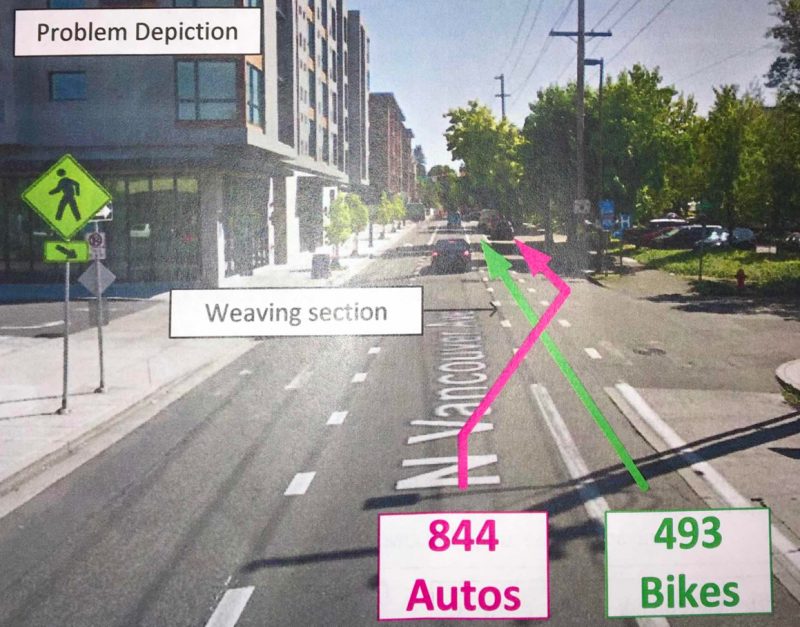
(Graphics: PBOT)
“We’ve been talking about this for three years now and we feel like it’s time to pull the trigger.”
— Wendy Cawley, PBOT traffic engineer
North Vancouver Avenue is one of Portland’s busiest — and most popular — bikeways. It serves as one side of the north-south couplet with Williams Avenue. And similar to Williams prior to its major redesign three years ago, Vancouver’s outdated road design has led to concerns about bike safety.
The Portland Bureau of Transportation revealed at the city’s monthly Bicycle Advisory Committee (BAC) meeting last night that they want to fix one section in particular: A tricky weave between Fremont and Cook. This is the block that includes; traffic from New Seasons Market, a busy bus stop, a new multi-level apartment and retail building, and traffic from ramps onto Interstate 405 at the Fremont Bridge.
At last night’s meeting PBOT staff presented the issue and asked for feedback on several options for how to make it better. Here’s how they described the problem:
“Due to exceptionally high volumes of through cyclists and right turning vehicles, the existing weaving section on N Vancouver Ave approaching Cook St does not work smoothly. Available data for the segment show approximately 500 through southbound cyclists on N Vancouver Ave conflicting with approcimately 850 motor vehicles attempting to turn right onto Cook St. This location has been thew subject of several complaints over the years, especially from cyclists.”
DMV data shows two collisions in this location between 2010 and 2014 where an auto user collided with a bicycle user in a “sideswipe overtaking” collision. (Keep in mind DMV data is not representative of all collisions and many go unreported.)
PBOT Engineer Wendy Cawley and Bicycle Coordinator Roger Geller both acknowledged last night that this block of Vancouver has been on their radar for a long time.
“It’s been a vexing problem for us,” Geller said. “We’ve taken runs at it through the years without doing anything… We need to figure out how do we fix this problem.”
Cawley said, “We’ve been talking about this for three years now and we feel like it’s time to pull the trigger.”
They presented six options last night. Each one came with a graphic, a description and a comparison of pros and cons. They ranged in price from $10,000 to $200,000. Cawley said PBOT Director Leah Treat has all but promised she has $50,000 ready-to-go for whatever option is chosen. More funding is possible if a strong case for its benefits can be made.
Here are the six options presented last night. As you peruse them, please keep these points in mind:
- PBOT shared them soley to provide a window into their thinking in hopes of getting productive feedback.
- These are not official plans and they haven’t been vetted with partner agencies and neighborhoods.
- The mid-block bus stop (on west side of Vancouver) is used by 11 buses per hour in the AM peak.
- One option discussed by committee members and PBOT staff was to work with TriMet to move the bus stop further south.
- Geller said, “There are no silver bullets and there are tradeoffs with all the options.”
- Cawley said, “We’re looking for ways to try and either eliminate the weave or minimize and separate cars and bikes being in the same space at the same time.”
- During the AM peak hour PBOT counted 844 drivers merging over to go right on Cook and 493 bicycle users going straight.
- In a separate planning excercise, PBOT is working with TriMet to improve bus service on this street. At last night’s meeting it was clear that the bike planners and transit planners weren’t in contact yet.
Here are the options (I’ll let PBOT’s graphics do most of the talking):
1) Bike Box & Right Turn Lane at Vancouver and Fremont – Estimated cost $10,000
Advertisement
2) Bike Queue Jump at Vancouver and Fremont – Estimated cost $50,000
3) Split Signal Phase at Vancouver and Fremont – Estimated cost $100,000
4) Bike Signal at Vancouver and Cook – Estimated cost $50,000
Cawley mentioned that addiong a bicycle-only phase to the signal would add a 90 second delay for auto users and would increase the auto back-up by 400 feet.
5) Prohibit and Divert Right Turns from Vancouver to Cook – Estimated cost $100,000+
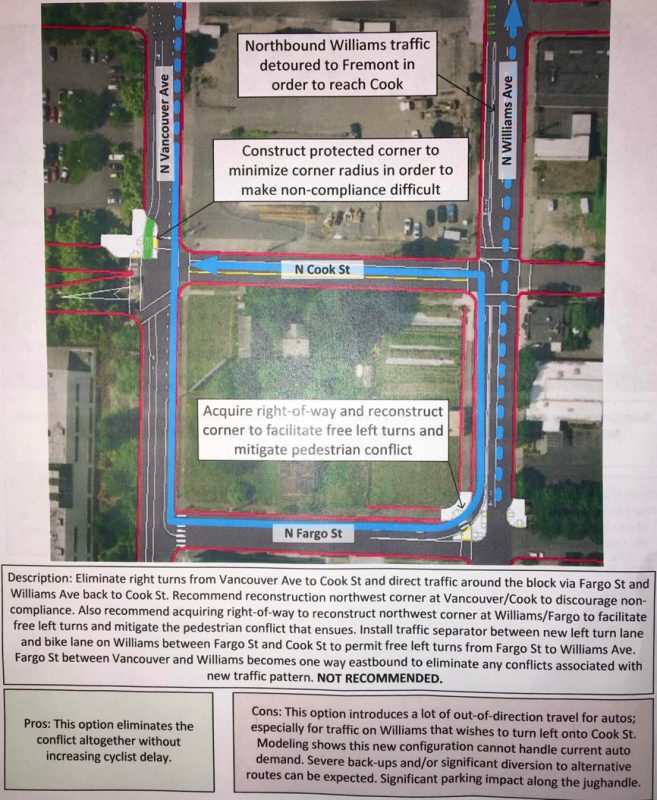
This is similar to the I-405 exit and transition to NW Glisan in downtown Portland. The vibe at the meeting was that there’s no way PBOT would move forward with this. They shared it only as a brainstorm to let people know some of the ideas they’ve considered.
6) Move Bike Lane to the Left Side from Skidmore to Stanton – Estimated cost $200,000
This was the most highly regarded option from committee members (and note that it’s “Recommended” by PBOT as well). Discussion revolved around what intersections would work best for transitioning bicycle users from the right to the left and then back again. While paint striping is cheap, the cost reflects the need to add bike-only signals at those transition points to get bicycle users across traffic to the other side of the street. Another important thing is the scope of this option. Because of how how large it is geographically (relative to the other options), this would require more of a public outreach process. And the memories from Williams Avenue — which started in much the same way — are still fresh in many peoples’ minds.
At the end of the BAC meeting last night, committee Chair Rithy Khut expressed some frustration around PBOT’s discomfort with options that would cause increased delays for auto users. “In the end, if we’re talking about safety and Vision Zero, it makes sense to add signals and just make cars wait,” Khut said. “If we’re prioritizing safety we’d signalize it and add delay. That would ensure everyone knows what they’re supposed to be doing and there would be no ambiguity.” Khut also said the bus stop could stay if it were redesigned as a “floating bus island” with the bike lane maintained curbside.
Another idea discussed (but not seriously) was to simply close the I-405 ramps at Cook. This entire problem exists because there are simply too many people driving and the on-ramp/off-ramp is a major destination.
Do you ride this section of Vancouver? What do you think about these ideas?
— Jonathan Maus: (503) 706-8804, @jonathan_maus on Twitter and jonathan@bikeportland.org
BikePortland is supported by the community (that means you!). Please become a subscriber or make a donation today.

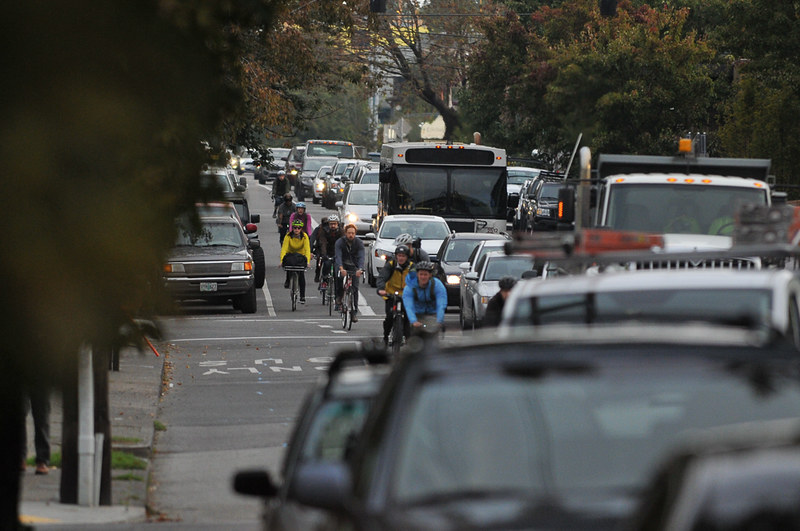
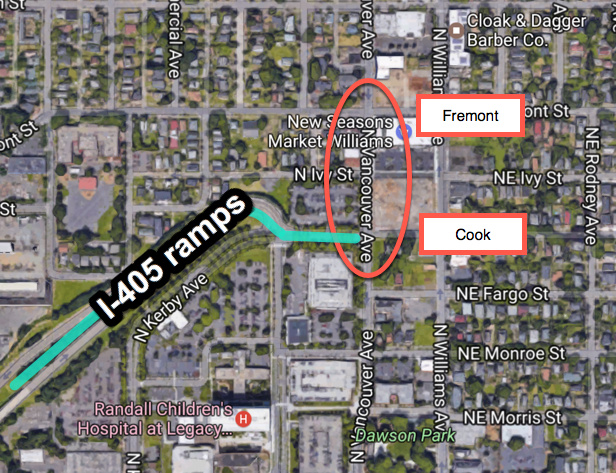
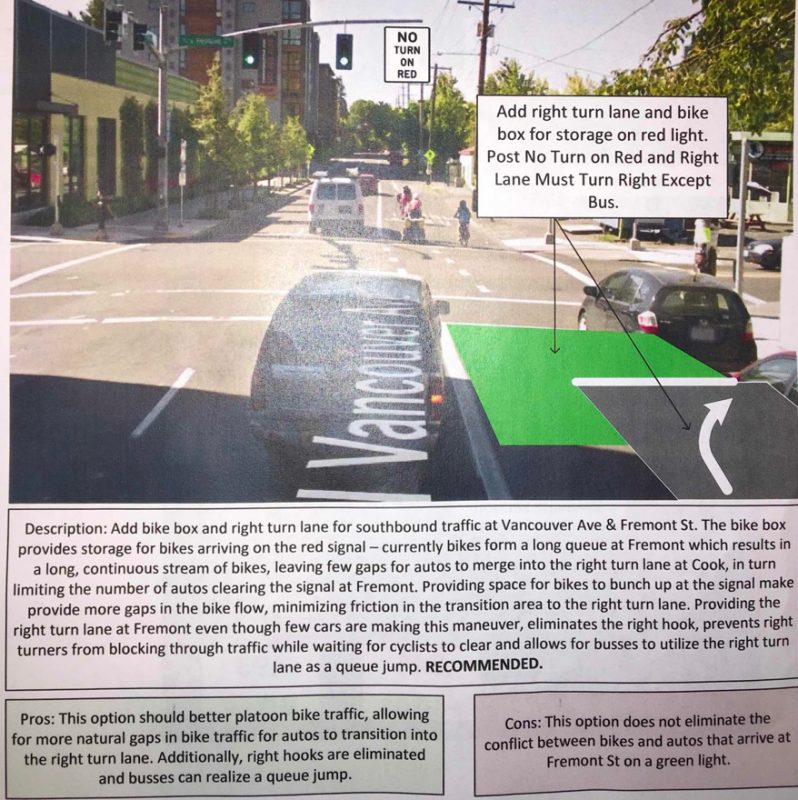
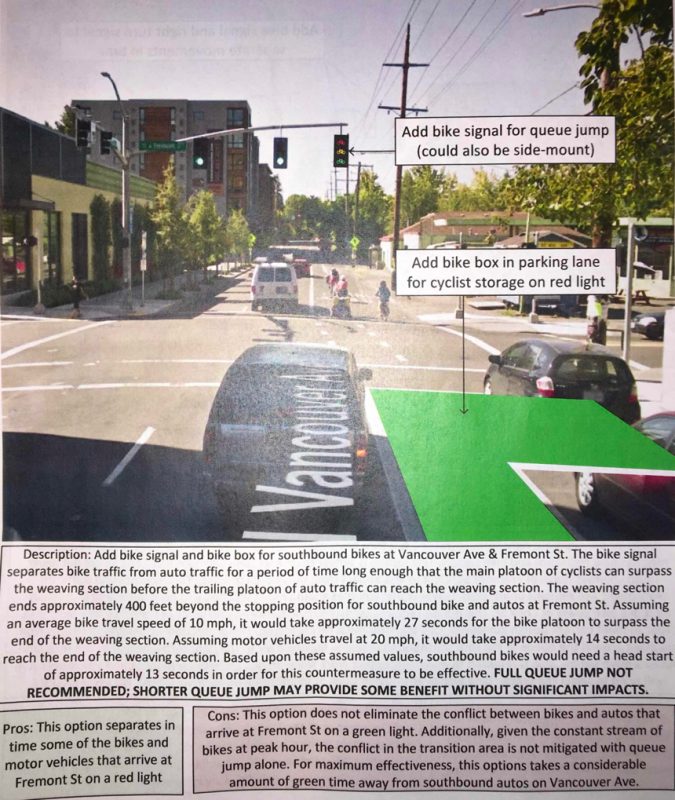
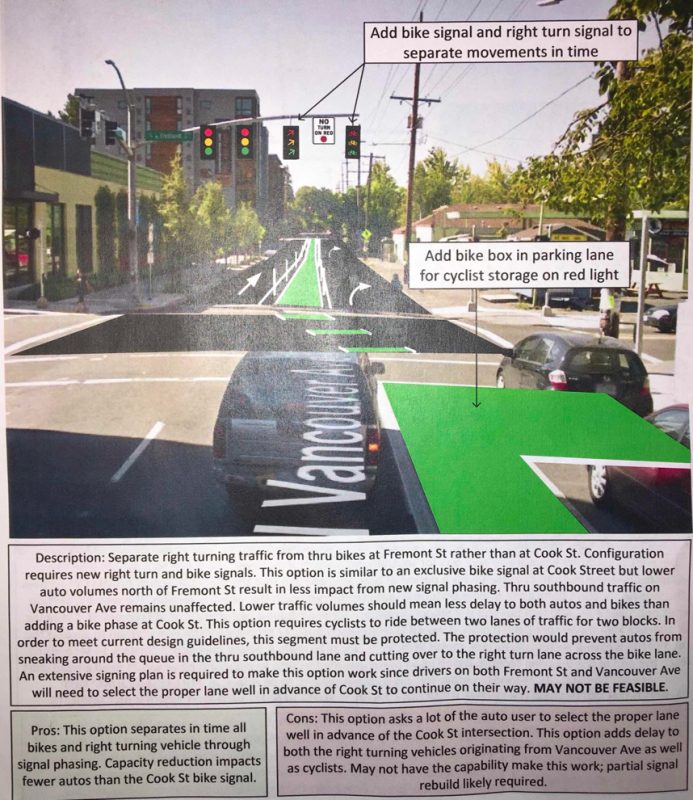
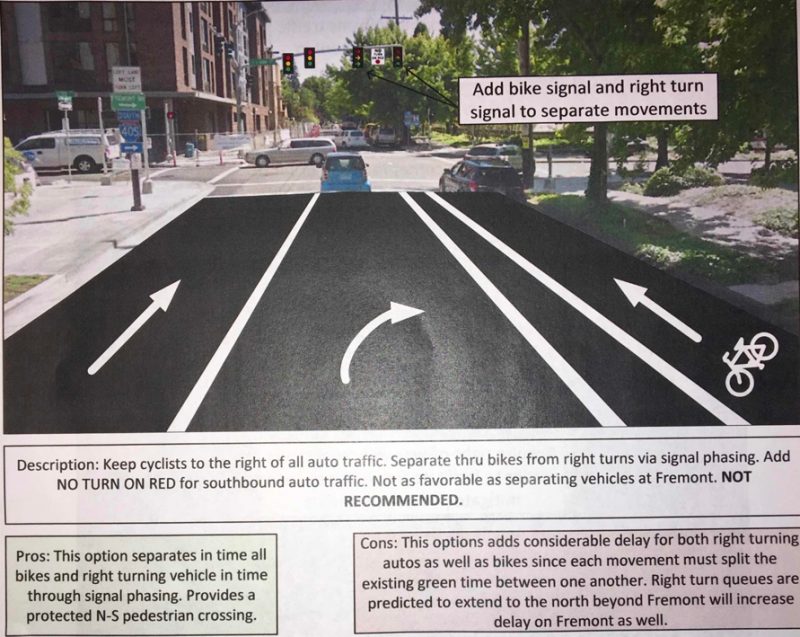
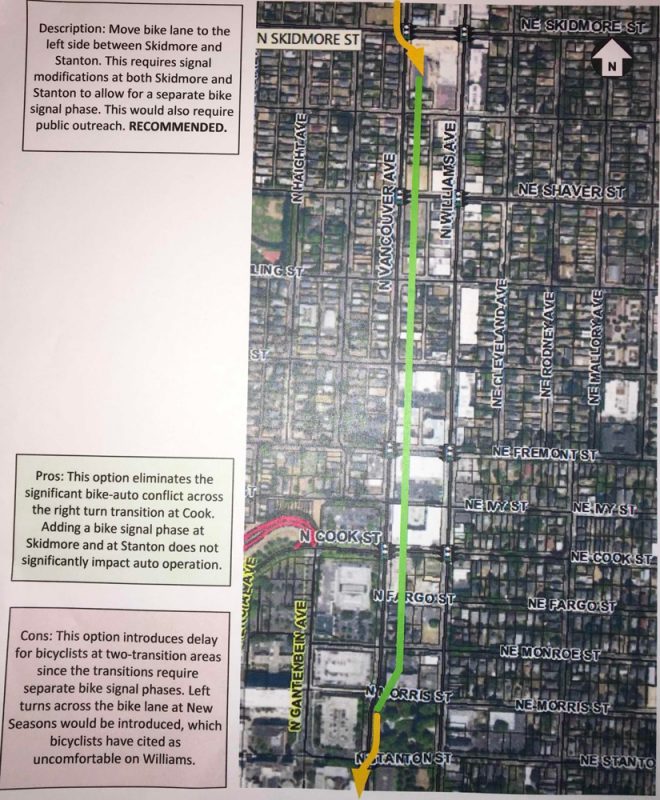
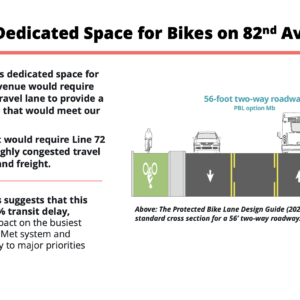
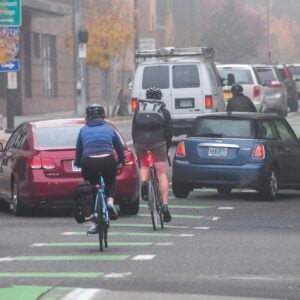

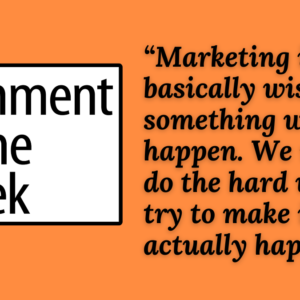
Thanks for reading.
BikePortland has served this community with independent community journalism since 2005. We rely on subscriptions from readers like you to survive. Your financial support is vital in keeping this valuable resource alive and well.
Please subscribe today to strengthen and expand our work.
No left side bike lanes! The N Williams redesign was bad enough, no need to copy poor infrastructure a block away. Options 1-3 are all garbage and only amount to more paint for drivers to ignore. #3 being particularly – sandwiching a protected bike lane between two auto lanes makes no sense. #5 seems like the best option, giving a protected queuing area for cyclists. #4 seems like a decent backup, however I imagine that most drivers will ignore any turn on red restriction, as they do everywhere else in the city.
Seriously, though. #6 is easily the worst option, which makes sense why PBOT is recommending it…
Goodness gracious, here I am agreeing with Adam H. Either I should buy a lottery ticket or PBoT really is so bad they can bring us two together in agreeing that the one option they came up with that they won’t seriously consider is the one option that has potential to actually work for both safety and getting people to utilize active transportation options.
At least we have slightly different reasons for preferring this not-quite-an-option. I’ll admit that anything that inconveniences motorists is something that I consider to be a good thing, and this is the only option that impinges on their privilege in any real way. It also has the virtue of not slowing down cyclists with extra signal delays and not endangering them with lousy crossovers.
Oh my, safety for vulnerable road users and a lack of delays for cyclists. No wonder PBoT won’t build it.
By the way, why should motorists having to circle a block be such a big deal? Cyclists routinely have to ride well out of their way to avoid overly dangerous situations. Add in the fact that motorists are content to circle many blocks in search of that perfect parking spot and this should be a no-brainer.
YES, this 100%!! PBOT intentionally builds infrastructure that directs cyclists blocks out of their way and away from their intended destination, yet when faced with doing the same for motorists, they balk. PBOT always wants to take the path of least resistance and that usually means making the motoring masses happy at the expense of truly useful cycling infrastructure.
Pareto optimality.
Makes no sense to spend a lot of money to serve a minority of users.
I agree, and wish we’d stop catering to the minority that drive trucks.
Unless your goal is to turn the minority into the majority. Regardless, even if we dedicate funding towards top-of-the-line cycling infrastructure city-wide, it would still pale in comparison with how much we’ve spent on highways and other auto-only infrastructure.
do you hate the ADA?
I’m sure he does.
Because circling drivers will have to cross bike traffic on Williams twice, creating more conflict than the Vancouver-Cook right turn.
Oh gee, you’re right, because of the left side bike lane on Williams.
That’s not the way the (early) sketch shows it. They’re showing a dedicated new circling lane on Williams, replacing parking to the left of the bike lane.
Graphic makes it look like they’d get rid of parking along Williams from Fargo to Cook to make a block long turn lane with a curb separating it from the bike lane. Drivers going around the block instead of turning right off Vancouver wouldn’t conflict with bike traffic on Williams. Drivers heading north on Williams would no longer be able to access the turn lane to make a left onto Cook. I don’t know if PBOT had in mind to ban that turn or direct drivers to go north to Ivy or Fremont to get to Vancouver to access the turn from Williams to Cook or what.
I agree with you for a change, even though it would be personally beneficial.
Get rid of the I-405 ramps and rebuild the neighborhood grid where the ramps are now.
At a minimum, the City needs to work with the hospital and ODOT to truncate the ramps and create a signalized intersection with the hospital at Morris. This would restore at least some of the grid and return acres of land to the city for either park space or development, without restricting traffic flow (it would likely improve it). This would take some pressure off of the Vancouver/Kerby intersection, as more routes could be used to access the ramps.
Think big, people!
Rebuilding the ramps to intersect at Morris would be weird, I think, and you’d have to recontruct both of the viaducts, at well. However, it would only take a lot of dirt work to rebuild the ramps to intersect with Kerby where it kinks. The current design is very strange and even a small change would be transformative.
I’d just close Cook and force traffic to use Kerby south to Graham. The irony here is that the area north was the black area of town “back in the day”, and PBOT (or its predecessor Department of Public Works) deliberately discouraged any good connections to Fremont by ODOT. Now that the area is fully gentrified, you have the usual white car drivers versus white bicyclists conflict, both in unusually large numbers, plus the nearby hospital. If you close Cook, expect resistance from New Seasons, who clearly want the car traffic they get.
Just the on ramp. The off ramp provides access to a Level 1 trauma center.
Agreed, this seems like the best long-term plan. Depending on which direction you’re coming from, it adds fairly minimal delay for autos — less than 5 minutes / 1.5 miles, and in many cases less. As others have said, emergency access to the hospital seems like the only sticking point.
Simple and quick experiment: temporarily close the I-405 on-ramp and monitor the results.
I like left side bike lanes. It’s too bad it is the most expensive, but it makes the most sense from a safety standpoint by reducing most conflicts. Plus, it would be easier to turn onto Vancouver from Going.
The left-hand bike lanes just convert right-hook conflicts into left-hook conflicts. They don’t add any safety, plus they put slower bike traffic on the wrong side of the street, adding confusion for drivers. Left-hand bike lanes only serve as a cheap way to get out of building protected bike lanes and bus islands.
Cook left onto Williams is no turn on red, and there’s no parking on the west side (left side with the bike lane) of Williams for 100 feet before the intersection because it’s a left turn lane. You either have a different street in mind or you’re talking about either making an illegal turn on red or when you have a green being vigilant in watching out for cyclists heading north on Williams who are running a red light.
And I don’t have a mirror on the right side of my handlebar. Not comfortable not being able to see what’s coming up right behind me.
This is an advantage of glasses mounted mirrors.
But you raise an important point. It is undesirable to have people need to recognize cyclists/threats/whatever in the opposite direction they’re used to.
This is a version of the same problem that happens when we have two-way “cycle-tracks” any time there is a driveway or intersection.
I always wondered why so many of the one way streets had right hand bike lanes. I know in the Oregon drivers Manual it always recommended that bicycles ride in the right lane on one way streets. I always rode in the left lane on Vancouver before it was striped for a right side bile lane. Other one way streets as well because motorists could see me better if I was in front of the driver rather than where the driver could crowd me into a parked car.
Been there dun that many times since 1953. Only a few scars from the parked cars on the right knee. None from being hit from behind while on the left side on a one way. Of course that is whay helmets are made for.
Sorry Adam.
Sorry I mis-spoke. The Driver’s manual always said “Bicycles should ride in the left lane on one way streets.”
I think if we’re talking left side bike lane we should go all the way down to the rose quarter and not switch sides twice. I see this switching sides twice idea as terrible.
Did they consider putting bikes in the middle between a left/straight lane and a right/to the freeway lane before Fremont? This seems like it could help a bunch and if not, why not?
How about making Vancouver and Williams both two-way streets, but Vancouver car-only and Williams bike-only?
Brilliant but probably super expensive, and the business owners on Williams will cry and block, even though car-free areas often result in increased rather than decreased business.
You know an idea is really good when it takes ages to suggest but, once it’s out there, it seems obvious.
I’m having that reaction here. I get that anything like this may produce push-back, but…this is a very good idea that I hope PBOT will add to the menu of considerations.
How do people that live on the bike only street get their cars to their garages?
They don’t. That’s the idea. 😉
Easy enough, you create a series of diverters and cul-de-sacs along Williams, forcing local traffic into side streets and not allowing through-traffic. Nothing that Portland hasn’t done before, a bit like Clinton.
Yes – if they do a left side bike lane it needs to extend the length of the entire corridor. The experience of changing from a left side bike lane to right side on bike on SW 14th is miserable.
ah. but it has so many lanes for cars. that’s why it didn’t make sense
Allen . Going to the rose quarter would be good but myself when I am onVancouver I always take the jog to the right after the hospital to be lined up for a right turn at Broadway avoiding confusion and freeway exit traffic from I-5.
I wonder how that would impact all the right hand turn bike traffic onto Russell.
whoa, slow down Wendy, you wouldn’t want to act expeditiously to save lives. are you sure 3 years is long enough?
Yes, in East Portland it takes them 25 years to make a decision. They have another 22 years to decide between the listed choices. Lots of meetings coming up.
All of the traffic turning left onto Vancouver from Fremont would still have to cross the bicycle lane, which means the problem won’t have been dealt with in as significant a way as the proposed solutions.
My idea costs a little more, but may actually solve the problem and serve most stakeholders’ needs/desires without any new signals, sharrows, or weaves.
1. Return bikes to the right side of Williams
2. Eliminate street parking on Vancouver
3. Convert Vancouver to two-way auto traffic
4. Buy the underutilized hospital land on Russell
5. Merge Williams auto traffic to Vancouver (see NE MLK/Grand)
6. Convert Williams to two-way bike traffic
7. Add access lane and parking buffer on Williams as space allows
8. Reuse Williams diverters to limit access lane abuse
Excellent!
6. Convert Williams to two-way bike traffic * street is crazy these days *
But he’s diverting autos to Vancouver so Williams would be car-free, I think. It would be much less crazy than it is now.
While the left-side running lane on Williams has been an improvement with some growing pains, running it on the Vancouver lane on the left for only a short segment on Vancouver doesn’t make much sense to me.
There are not many drivers who turn WB onto Fremont from Vancouver. The bigger issue is closer to the ramps. Bikes need more space either way, and not many folks make the turn EB onto Cook from Vancouver.
I like a combination of 1 & 3. Keep it mostly as is, except make both the bike lane and right turn lane larger and flex-post separated, with a very clear gap where drivers can merge into the right lane over the bike lane.
Turning right onto Cook from Vancouver would be a westbound turn…I think Steve B. is onto something here. I ride or drive this route almost every day, and one major added issue now is the cars that race from Fremont up to Cook in the Vancouver left lane (which is left turn only at Cook) and then ignore the left turn only sign and dart over to the right lane to continue straight. They frequently do this at a high rate of speed to beat the cars in the center lane of Vancouver. It’s added a new element of danger for cars and bicycles. They should add some flex posts to this area to stop this in the meantime.
I have hope for this intersection (and Portland’s bike infrastructure more generally) when PBOT finally prioritizes bicyclists and pedestrians over cars.
I’m with Peter W, get rid of the freeway ramp completely…
having so many ramps in the middle of the city is an abuse of the freeway system, which was designed to connect cities to other cities and not to connect cities within themselves and create the kinds of transportation issues we’ve been facing for over 50 years…
And yet… diverting more vehicles off local streets and onto highways can be a good thing.
Agreed. Tho that does help make the case for highway widening. How many people opt to bypass the highway congestion by taking surface streets?
I’d rather there just be less cars rather than simply moving them around.
that’s the thinking that got us into this mess… continuing to allow the free flow of vehicles once they crowded the local streets… had we left no inner city freeway access then people in the city would drive less because they would otherwise create gridlock… but now we have more cars on local streets because they’re all trying to get to a freeway…
Vancouver is wide enough for a PBL along the majority of its route. Option 4 would continue the PBL and also be the most cost effective. Signal separation is a must when the counts are this high.
The most expensive option: Car tunnel, starting at Fremont + Vancouver, for the 405 on ramp. Bikes and cars on separate signals. Expensive. Yes, but might work.
More expensive option: rocket powered bike lifts to go over the intersection.
I ride this everyday and I like options 5 and 7 ( the one mentioned at the end) . At this point in the history of the world we should be trying to discourage auto traffic and encourage cycling. We desperatly need to eliminate private automobile use in the near future if we are to have any hope hitting climate goals and saving the planet. Causing inconvenience for auto users should not be one of our worries. Encouraging people to live in near NE and drive to Beaverton everyday to work is a bad idea and we shouldn’t enable it.
My vote would be to close or greatly shorten the freeway ramps. My second choice would be to have the cars make 3 lefts, but get rid of that ped-unfriendly bit of infrastructure that allows a “free right”. My third choice is the left side bike lane, but it should begin and end as a left-side bike, not weave over then weave back across!
Finally, I truly hope they consider adding bike infrastructure to Skidmore between N Michigan and NE 7th so people on bikes can use the safe, signalized crossing to travel east/west. I have more conflicts on SKidmore than Vancouver, and I find using Going regularly puts my life in danger.
I would oppose any plan that involves a no right turn on red sign. I have never once in my life seen such a sign stop people from turning right on red. Car after car goes, with the sign at least unheeded if not unnoticed. Every single one of those signs in existence needs to be replaced with a red turn arrow signal. I have noticed those are slightly less ineffective.
In Oregon, it is legal to turn right on a red right-arrow.
I see people turn left on a left red arrow at 12th/Clinton every day.
They turn from Clinton to 12th, and go the wrong way on a one-way street? (That’s the only left turn you can make at that intersection.)
Oh, you must mean the cyclists who flagrantly violate a number of traffic laws there because it’s the only sane way to navigate the stupid intersection.
No, northbound onto 12th from Clinton (look closer, the street continues southwest to Powell). People turn left on red there whether or not there are cyclists or people on foot trying to cross.
And yes I am one of the people who ignore all traffic control devices in that area. None of it makes any sense and cyclists are often held up at reds for what appears to be no good reason (the actual reason is to allow a semi-truck to clear the intersection without getting stuck on the tracks, though I have yet to see a single truck there and I ride though twice daily). That intersection is so poorly designed that the only solution I can see at this point is a bike bridge over the tracks.
Ah, quite so, though that’s Gideon, not Clinton. Turning left on a red arrow is legal there. It is a one-way onto a one-way.
It is not legal if there are people crossing the street.
That’s not correct either; the pedestrian needs to have cleared the receiving lane, and 6 ft of the next lane, after which point drivers are free to legally proceed, even with pedestrians still in the roadway.
I should be so lucky to get so much room from drivers. Usually I get inches, even when I’m pushing a stroller.
Also, the law in Oregon is ridiculous. In Illinois, turning on a red arrow is illegal. Red arrow is the same as a “NO TURN ON RED” sign. In Oregon, however, you could be crossing the street with the white man and still have a car cross your path. It makes no sense.
The law in Washington is the same. The arrow is only to reinforce direction of travel.
BTW, it is legal to turn left on red onto a one way street from a 2-way street if the one way street is going to the left.
As usual, the ‘most vexing’ bike infra problems occur at Freeway on and off ramps, and this is no exception.
My solution would be to close the I-405 ramps.
close the on-ramp. the off-ramp provides access to a level 1 trauma center.
Can’t we just do Elon Musk’s thing and make all the cars go underground? Or did he want them to go to space? Or be solar powered? It’s hard to keep up with him.
It must be nice to be so rich that you can just say whatever crazy nonsense idea that comes to mind and have people write entire articles about it.
Seriously. It’s not like he ever does any of the crazy stuff he talks about.
He did build those space ships…
Sure. What next? Electric cars?
Hyperloop is nonsense. He wants to hurt High Speed Rail so he can sell more cars.
I’m sure the possibility of high speed rail actually being completed has all the car makers shaking in their boots. Think of all the car sales that won’t happen because someone can take a train from LA to SF. It could be dozens!
Car ownership rates are significantly lower in countries that have fast, reliable public transit:
https://en.wikipedia.org/wiki/List_of_countries_by_vehicles_per_capita
This is true even in countries that have similar population densities, such as Sweden.
He threw out the idea of Hyperloop while the state was debating funding for HSR, and then hasn’t devoted any money or time to the project since.
It’s also worth noting that those countries have costs of car ownership far higher than in the US, and also that a high-speed rail backbone is one of the less important aspects of building a good transit system.
You say the hyperloop isn’t getting any attention now, but that’s simply not true. Type the term into Google and look at recent news coverage. Much to my surprise, it seems to be getting traction. I was among those who scoffed when I first heard about it.
If you are right that hyperloop was a scheme to derail high-speed rail in CA and ensure a strong market for car sales after it’s scheduled completion date of 2029 (actual date probably 2035), then Musk is clearly playing the long game. And his plot seems to be backfiring.
Portland has kicked around a plan for burying the east side freeways on and off for years, most European cities do it; however, there would still be problems at all the entrances and exits, so you would still need to restrict access even further than it is now.
Stupid Question: why are we at this point NOW?!@ Doing a costly redo that will suck project money from other bike per safety projects?
Was this not an expected outcome modelled during the design phase?!
Again I have to say: this is the regional bike hi-way for North Portland…can PBOT/ COP not do the right thing and prioritize the thousands of bike commuters that depend on this corridor (and have fuelled the high-rise redevelopments [better than the Yellowline LRT too?)]
One thing I’d add to this conversation, especially about #2 and #4: When I ride through this with my son in a burley, it’s pretty scary right now. But a separate phase would need to be *really long* if the intention was to let bikes totally get clear of the right turn onto Cook–assuming those bikes were people like me lugging small children in burleys. Option #3 helps with that problem and might be the best of the PBOT options to my eyes. Not great, but… better. I think.
And while we’re at it, please remove the auto parking on Skidmore from Interstate to MLK and add some damn bike lanes! That street sucks!
It’s interesting that the offramp to Cook almost touches N Commercial Ave. If only it would connect, a lot of turns and intersections would be eliminated for drivers accessing I-405. Of course there are multiple problems, namely that Commercial and its intersection with Fremont are not nearly wide enough to accommodate all that traffic, and it’s right next to Boise/Eliot school.. Last thing we need is impatient drivers running over schoolchildren.
I think a LOT of people from the NE and N neighborhoods use I-405 and the Fremont bridge as a flyover to downtown instead of taking surface streets. The real solution is getting these people to their destinations without needing to drive at all, but I feel like it will be a cold day in hell before that happens soon.
Exactly.
How about we change the driving culture? The car crossing is inherently dangerous because cars drive aggresively there. How about a “crossing guard” type posted there with video camera on the lights? You don’t have to issue tickets but you can for repeat offenders. They do have them for cross walks at schools during peak times and cross walk compliance is greatly increased. Sometimes a witness ( whether cop or crosswalk guard) is all you need. I understand this doesn’t help during non peak times but just a thought.
What if it was like the Broadway and Vancouver intersection? Shared bike and bus lane between Vancouver and Cook with a separate right turn signal for cars (at Cook onto 405) and another for cyclists heading south on Vancouver? No right turns for autos onto WB Fremont.
Dip the right turn (auto lane) below grade, turning under the bike line and popping back up. Conflict eliminated. Cost? Probably prohibitive.
It would probably be cheaper to elevate the bike way. Here’s my thought. You block Cook from Vancouver to the 405 ramps. Traffic to and from the ramps goes behind the hospital complex (or in the case of emergency vehicles into to the hospital) along Kerby and on Russell. You start an elevated bikeway on Vancouver between Monroe and Morris streets. It basically stays flat while Vancouver drops down. At Russell, bikes are about 20′ above the street level, after which you bring the bike way back down to street level. The bike way is southbound only so no cyclist needs to worry about the climb back northbound. Motor vehicles headed to and from 405 cross under the bike way at Russell and swing back round to the ramps. The hospital loses Stanton and Graham access to Vancouver, but retains Knott and Monroe.
I didn’t see anyone suggest what I think will be the inevitable solution:
Make Williams a 2-way bikes and pedestrians only street.
Make Vancouver a 2 way cars only street (with at least a center suicide lane, or it could even fit 2 lanes in one direction.
The solutions proposed address today’s problems, but that area hasn’t reached half the population density it will have in the next 10 years. This idea gives cars easy access on/off the 405 ramps and allows them to avoid conflict with cyclists. Existing lights can be tweaked to allow thru-traffic. It also opens up Williams to being the high density, open market that it’s building itself up to be. It will make biking immensely safer, with fast and slow lanes… and no car weaving.
It won’t be the cheapest solution, but everything else just seems like it’s kicking the can.
I hope those newcomers don’t bring their cars. For most of us, a car-free lifestyle is what aspire for others to have.
I think Williams is the wider of the two streets. Makes more sense to put the cars there and bikes/peds on Vancouver. Williams is already built up pretty nicely. I think that would get Vancouver looking as good pretty quickly.
Might a leading pedestrian interval on Vancouver at Fremont that cyclists could use be as effective as adding a bike only signal, for like $500?
What if every signal intersection on Vancouver and Williams had one?
Since it appears that we can not count on the president or congress to make progress on climate change lets use situations such as this to make concrete progress on saving the planet in a incremental cost effective manner. Each time we have a street that has dangerous conflicts between automobiles and bikes/pedestrians, just close it off to automobiles permanently. That way driving will become more and more impractical,and the number of cars will decline. Individual humans transporting themselves around in 4000 lb hunks of metal is a bad habit that has to come to end soon ( like tommorow) if we are to have any hope of sustaining human and animal life on earth.
#4 would be good if far-right lane becomes a protected bike lane with bus stop shifted out between far right and middle lane and integrated into the barrier. Make middle lane right turn only and far-left lane right turn optional or straight to deal with extra signal time. Cars merge on cook to get to 405 ramp. Pedestrian crossing from new seasons across Vancouver could be improved as well. It sucks right now.
#1 and #6 appear to create more danger/ conflicts for bike riders.
1. I’m glad we’re talking about how poor the current setup works.
2. Option #3 looks like a shit show.
Why not do #5, but without all the “free left” rebuilding? Sign left turns from Fargo -> Williams as “TO COOK ST ONLY”, and no left turn from the right lane. Without the channelization construction, Williams drivers could still turn left at Cook, they’d just have to fight it out with drivers turning left from Fargo; boo-hoo, this happens at other locations. They could still curb-separate the left turn lane from the bike lane between Fargo/Cook if we turned the parking lane between Monroe/Fargo into a pre-left-turn-only-at-Cook lane. Some of the parking impact could be mitigated by allowing parking in a decommissioned right-only lane on Vancouver. I love the comments on this option in the photo:
“Pros: This option eliminates the conflict altogether, without increasing cyclist delay.”
“NOT RECOMMENDED”.
Disclaimer: I do not ride in this area; suggestions are based solely on theory and the accuracy of online map tools…
I hate to say I told you so, but… three or four years back: I told you so.
Why isn’t there an option to turn Williams or Vancouver into bike only (both directions) and make the other street for car travel both directions? I’m being very serious — where’s the big vision? I’d imagine bike ridership would surpass car ridership in that case (because the numbers show they aren’t far off as it is).